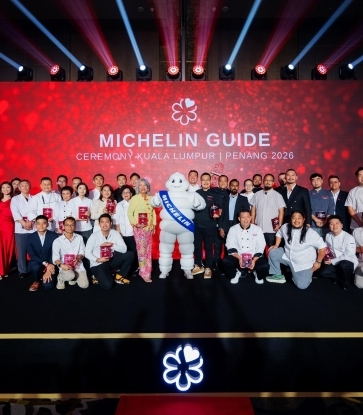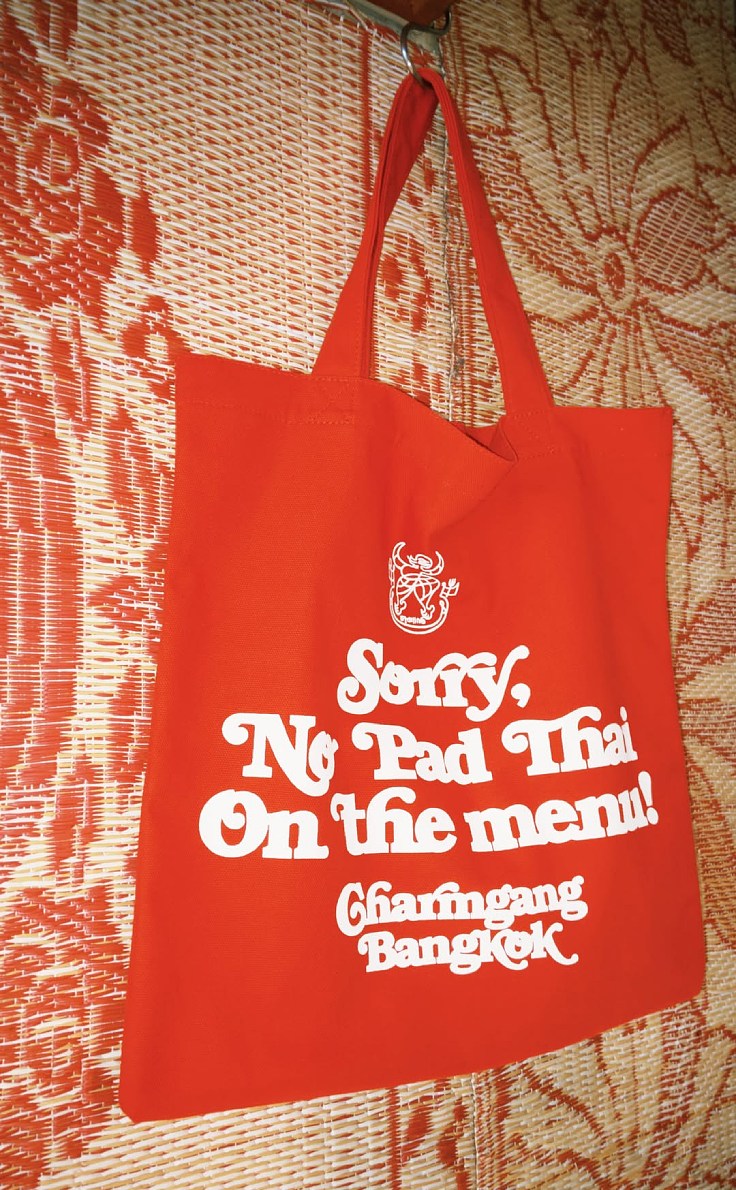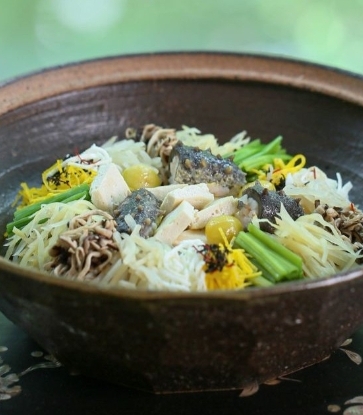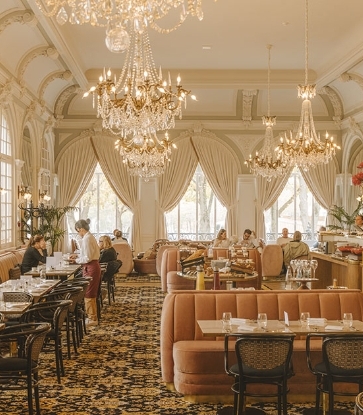For a split second I felt confused and disoriented. Had I just walked into a bathroom? Am I in the wrong place? I mean, the door outside is unmarked….
No no. Step into COQODAQ, the sophomore, Korean-American fried chicken concept from Simon Kim (Gracious Hospitality Management) of Flatiron’s nearby one MICHELIN star COTE Korean Steakhouse, and come face-to-face with a row of three black soapstone sinks upon which sits Hermès hand soap. Because you’re here for finger food––crowned with caviar––so you better wash up.
A cavernous, nearly 8,000-square-foot, 190-seat dining room fit with comfortable hunter green booths illuminated by glowing glass and bronze arches fill the space. A long 18-seat bar spans the restaurant’s length; here you’ll find barman Sondre Kasin (Cote, Undercote) slinging ‘coqtails;’ a mix of classics, along with tea-based libations and those that serve a function beyond taste. For example, Boricha calls for a blend of watermelon juice, coconut water, barley and whiskey, “which is super hydrating and works as a hydration piece together with the food,” explains Kasin. Up front by the host stand sit four high-top tables with eight bar stools that are reserved for walk-ins. Which will come in handy when you simply can’t get in.
A few minutes after sliding into my very spacious booth I am presented with an iPad displaying the largest Champagne list in America, a work curated by Victoria James who has earned serious street cred for the French-focused, low-intervention list over at COTE. In its entirely, COQODAQ counts 600 bottles, 400 of which are bubbles from rare Selosse to 1985 KRUG.
A fitting, yet fancy pairing for the humble bird, especially when a diner can walk in and drop $38 for a multicourse set menu––though one prepared by former Jean-Georges chef Seung Kyu Kim. But it would be easy to spend more. There’s $4 oysters, and a trio of tartares from the menu’s raw bar section––black truffle soy sauce-laced ocean trout, Calabrian chili-spiked sustainable tuna, and amberjack flavored with horseradish and the grapefruit-esque Korean citrus yuja––runs $68, served beside skinny sourdough chips. Some of Kim’s friends, like rappers Nas and Busta Rhymes, might opt for the Petrossian Royal Beluga at $208 an ounce, or $807 for a 4.4 ounce tin.

But the thoughtfulness here, and partly why COTE has proven such a success (remember, the restaurant offers a $74 prix fixe Butcher’s Feast), is that the menu is designed for most; those on an under-$50 budget, and those ready to spend can share a table.
By now you know that COQODAQ’s shining star is fried chicken, with a supporting cast of Korean and American small plates. While placing your initial order, those who sign up for ‘The Bucket List’ (chicken is also sold individually by the piece), as the set menu here is named, need only answer one question: do you prefer a more savory and umami-rich soy sauce garlic glaze, or a sweeter and spicier one made from the fermented Korean red chili paste gochujang?
And seemingly almost as quickly as I set my cup down came the first wave of fried chicken, served in a gray ceramic COQODAQ-branded bucket; the service piece––along with much of the other plateware–was designed by Jono Pandolfi, who is somewhat of a ceramicist to the stars.

“We tasted over 50 different fried chicken brands and countless chickens from various farms in the US,” says chef SK of his research and development process to settle on his ideal bird. Ultimately he chose Amish birds from Pennsylvania that are free-range, hormone and antibiotic-free, “and are fed a surplus vegetable diet.” He brines the meat for 24 hours before coating the animal’s diced sections in a rice flour mixture (so yes, the chicken is totally gluten-free) along with cayenne pepper and ginger powder, and fries it multiple times. What emerges from the hot oil is a thick and crisp shell that mummifies the extraordinarily plump chicken within, ensuring its internal juice doesn't spill out. Until you take a bite, and that’s another story. Just have napkins ready.
A few banchan, including sweet diced pickled daikon radish and more savory pickled celery slices accompany the bird, in addition to four mini squirt bottles filled with honey mustard, pepper-Parmesan, gochujang barbecue, and a verde sauce flavored with Thai chili and lime, for dipping.
And just as I was about to pick up my second piece of chicken, the second wave of bird hits.

Chickenland course two arrives on a glossy black pedestal—the bird itself just as lacquered in one’s aforementioned desired dressing. And then come à la carte sides. Hopefully you’ll have ordered the mac and cheese––it screams Velveeta in the best possible melted plastic sauce kind of way (seriously, it’s amazing). Chef SK uses a secret cheese blend that incorporates American cheese for an end result that also has some floral notes. The spicy rice cake called tteokbokki lurks under a hot lipstick-red Korean chili sauce and is another fun choice––the pro tip here for hot sauce fans is to dunk your bird right in.
You’re in Chickenland and it’s time to come down to earth. Slippery, cold perilla seed-dusted noodles begin the descent, while tangy lemon frozen yogurt soft-serve with blueberry sauce complete the mission.

COQODAQ isn’t your run-of-mill chicken shack––far from it. And the team is doing many things differently, including the oil in which the chicken is fried. Year-and-a-half-old start-up Zero Acre Farms produces an oil made from fermented sugarcane, and chef SK uses it for all frying; Zero Aces claims that their oil is a 90% monounsaturated (and heat-stable) fat, making it even healthier than olive oil.
Kim also made efforts to focus on sustainability. He and the team are working with Peat/Afterlife Mushrooms, a NYC-based circular farm, to upcycle the restaurant's food waste. COQODAQ is also extending its oil life by using advanced Henny Penny fryers that have an integrated oil filtration system, which helps minimize the environmental footprint of the restaurant. And once spent, that oil gets repurposed into biodiesel fuel.
"I love fried chicken,” says Kim of his decision to open COQODAQ, but he goes on to add that he “saw an opportunity in the market to create a fried chicken concept that focused on doing things better.” Fried chicken that’s “better tasting, better for humans, and better for the planet.”

Simply put, COQODAQ is an elevated take on a shared comfort food from two unique culture.
But the message is greater than crispy chicken (and caviar, and Chamapagne)-–it’s how can we be better, without sacrificing flavor? How can we improve upon one of the most iconic dishes, one of the longstand bastions of comfort food served in many countries around the world?
Can it be done? COQODAQ is certainly trying.
Hero image: Jason Varney for Rockwell Group




















